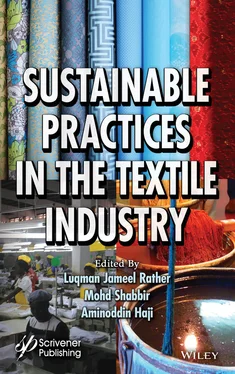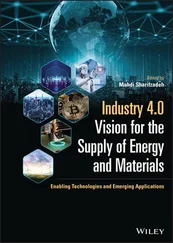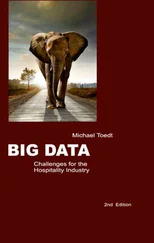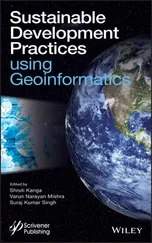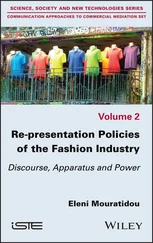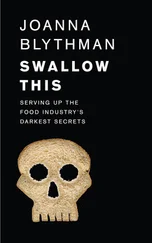Sustainable Practices in the Textile Industry
Здесь есть возможность читать онлайн «Sustainable Practices in the Textile Industry» — ознакомительный отрывок электронной книги совершенно бесплатно, а после прочтения отрывка купить полную версию. В некоторых случаях можно слушать аудио, скачать через торрент в формате fb2 и присутствует краткое содержание. Жанр: unrecognised, на английском языке. Описание произведения, (предисловие) а так же отзывы посетителей доступны на портале библиотеки ЛибКат.
- Название:Sustainable Practices in the Textile Industry
- Автор:
- Жанр:
- Год:неизвестен
- ISBN:нет данных
- Рейтинг книги:5 / 5. Голосов: 1
-
Избранное:Добавить в избранное
- Отзывы:
-
Ваша оценка:
- 100
- 1
- 2
- 3
- 4
- 5
Sustainable Practices in the Textile Industry: краткое содержание, описание и аннотация
Предлагаем к чтению аннотацию, описание, краткое содержание или предисловие (зависит от того, что написал сам автор книги «Sustainable Practices in the Textile Industry»). Если вы не нашли необходимую информацию о книге — напишите в комментариях, мы постараемся отыскать её.
Sustainable Practices in the Textile Industry
Sustainable Practices in the Textile Industry — читать онлайн ознакомительный отрывок
Ниже представлен текст книги, разбитый по страницам. Система сохранения места последней прочитанной страницы, позволяет с удобством читать онлайн бесплатно книгу «Sustainable Practices in the Textile Industry», без необходимости каждый раз заново искать на чём Вы остановились. Поставьте закладку, и сможете в любой момент перейти на страницу, на которой закончили чтение.
Интервал:
Закладка:
Table of Contents
1 Cover
2 Title page
3 Copyright
4 Preface
5 Part 1: SUSTAINABLE DYE EXTRACTION AND DYEING TECHNIQUES 1 Extraction and Application of Natural Dyes 1.1 Introduction 1.2 What are Natural Dyes? 1.3 Why Natural Dyes? 1.4 What are Synthetic Dyes? 1.5 Sources of Natural Dyes 1.6 Types of Natural Dyes 1.7 Natural Dyes Need Fixing Agent (Mordants) for Bonding 1.8 Fibers/Fabrics Used for Natural Dyeing 1.9 Extraction of Natural Dyes 1.10 Dyeing Process 1.11 Evaluation of the Dyed Fabric 1.12 Some Special Characteristics of Naturally Dyed Fabric 1.13 Conclusion Acknowledgement References 2 Recent Advances in Non-Aqueous Dyeing Systems 2.1 Introduction 2.2 Supercritical Fluid Dyeing System 2.3 Reverse Micelle Systems 2.4 Solvent Dyeing 2.5 Silicone Non-Aqueous Dyeing 2.6 Conclusion References 3 Structural Coloration of Textile Materials 3.1 Introduction 3.2 Thin-Film Interference References 4 Enzymatic Wet Processing 4.1 Introduction 4.2 Enzymes 4.3 Function of Enzymes 4.4 Classification of Enzymes 4.5 Αn-Amylase Enzyme for Desizing 4.6 Pectinase Enzyme for Scouring 4.7 Protease Enzyme for Wool Anti-Felting 4.8 Cellulase Enzyme for Biopolishing and Biostoning 4.9 Hairiness Removal Mechanism 4.10 Enzyme Decolorization of Textile Effluent 4.11 Enzymes for Increasing Dyeability of Different Fibers 4.12 Conclusion References
6 Part 2: SUSTAINABLE FUNCTIONAL FINISHING OF VARIOUS TEXTILE MATERIALS 5 Coating Textiles: Towards Sustainable Processes 5.1 Introduction 5.2 Most Used Polymers for Coating Textiles 5.3 Traditional Coating Methods 5.4 Environmental Friendly Polymers 5.5 Sustainable Coating Technologies 5.6 Conclusion References 6 A Review on Hydrophobicity and Fabricating Hydrophobic Surfaces on the Textiles 6.1 Introduction 6.2 Self-Cleaning Surfaces 6.3 Applications of Hydrophobic Surfaces 6.4 Basic Theories: Modeling of Contact Angle 6.5 Techniques to Make Super-Hydrophobic Surfaces 6.6 Methods of Applying Hydrophobic Coating on Textiles 6.7 Contact Angles (CA) Measurement 6.8 Research Records on Hydrophobic Surface Production 6.9 Conclusion References 7 UV Protection: Historical Perspectives and State-of-the-Art Achievements 7.1 Introduction 7.2 Fundamentals Regarding UV Protection of Textile Fabrics 7.3 UV Stabilizers Beginnings and Initial Development 7.4 Conclusion References 8 Synthetic and Natural UV Protective Agents for Textile Finishing 8.1 Introduction 8.2 Ultraviolet Radiation (UVR) 8.3 Importance of Ultraviolet Protective Finish 8.4 Methods of Blocking Ultraviolet Rays 8.5 Ultraviolet Protection Factor Measurement System 8.6 Clothing Factors Affecting Ultraviolet Protection Factor 8.7 Mechanisms of UV Protection 8.8 Types of Ultraviolet Absorbers 8.9 Commercial Ultraviolet Protective Clothing 8.10 Nanoparticle Coatings for Ultraviolet Protective Textiles 8.11 Durability of Ultraviolet Protective Finish 8.12 Conclusion References 9 Sustainable Orientation of Textile Companies 9.1 Introduction 9.2 Textile Industry—Environmental, Social and Economic Issues 9.3 Circular Economy 9.4 Sustainability Circles 9.5 Circularity in the Supply Chain 9.6 Consumer Behavior of Sustainable Textile Products 9.7 Decision to Purchase Sustainable Textile Products 9.8 Policies and Strategies Used in the Sustainable Textile Industry 9.9 Conclusions References
7 Part 3: SUSTAINABLE WASTEWATER REMEDIATION 10 Sustainable Application of Ionic Flocculation Method for Textile Effluent Treatment 10.1 Introduction 10.2 Conventional Methods for Degradation of Textile Effluents 10.3 Surfactants 10.4 Adsorptive Micellar Flocculation (AMF) 10.5 Mechanism 10.6 Choice of Flocculant 10.7 Analysis and Calculations 10.8 Optimization of Conditions for Better Removal of Dye Using AMF 10.9 Potential Advantages of AMF 10.10 Application to Wastewaters 10.11 Conclusion 10.12 Future Prospective References 11 Remediation of Textile Wastewater by Ozonation 11.1 Introduction 11.2 Sources of Wastewater 11.3 Ozonation Remediation for Textile Water 11.4 Impact of Various Techniques in Combination Ozonation Process for Treatment of Textile Wastewater 11.5 Degradation of Dyes via Ozonation 11.6 Conclusion References 12 Design of a New Cold Atmospheric Plasma Reactor Based on Dielelectric Barrier Discharge for the Treatment and Recovery of Textile Dyeing Wastewater: Profoks/CAP Reactor 12.1 Introduction 12.2 Advanced Oxidation Processes (AOP) in Wastewater Treatment 12.3 Profoks/CAP Wastewater Treatment and Water Recovery System 12.4 Conclusion References 13 Nanotechnology and its Application in Wastewater Treatment 13.1 Introduction 13.2 Nanotechnology 13.3 Conclusion References
8 Index
9 Also of Interest
10 End User License Agreement
List of Illustrations
1 Chapter 1 Figure 1.1 Schematic representation of applications of natural dyes. Figure 1.2 Sources of natural dyes. Figure 1.3 Classification of natural dyes.
2 Chapter 2 Figure 2.1 Schematic diagram of the supercritical CO 2apparatus equipped. Figure 2.2 SEM photographs, (a): undyed fabric, (b & c): cotton fabric dyed with... Figure 2.3 The mechanism of the reaction between reactive disperse dyes and cell... Figure 2.4 Reaction of disperse reactive dyes with textile amino groups, for vin... Figure 2.5 Diagram of (a): the micelle, (b): reverse micelle formation. Figure 2.6 TEM images of reverse micelle-encapsulated Levafix-CA dye [63]. Figure 2.7 SEM photographs of the surface of cotton fiber, (a): before dyeing; (...Figure 2.8 Diagram of reactive dye in D5 medium.Figure 2.9 Color strength (K/S) values and fixation (%) of dichlorotriazine dye ...Figure 2.10 Interaction between dye and surfactant in D5 medium and D5 reverse m...Figure 2.11 Confocal fluorescence images of distribution of water (a, b, e, f) a...Figure 2.12 Adsorption of reactive dyes at isothermal conditions (20 °C), (a & b...Figure 2.13 The dyeing pilot plant of 25 kg [84].Figure 2.14 EDX Spectrum and SEM images of samples dyed in water medium (a), (b)...
3 Chapter 3Figure 3.1 Examples of structural color by interference on a soap bubble (a), gr...Figure 3.2 Various ways and methods of structural coloration on textiles.Figure 3.3 Schematic diagram of single thin-film interference.Figure 3.4 Schematic diagram of multilayer interference.Figure 3.5 Schematic illustration of the process of colloidal electrospinning an...Figure 3.6 Schematic diagram of co-sedimentation self-assembly of binary colloid...Figure 3.7 Photonic crystal patterns fabricated by P(St-BA-MAA)@disperse dye mic...
4 Chapter 4Figure 4.1 Beer manufacturing in ancient Egypt using enzymes reprinted from [2] ...Figure 4.2 The course of an enzyme reaction [6].Figure 4.3 Classification of enzymes reprinted from [7] with permission from Els...Figure 4.4 β-elimination mechanism for α-1,4-polygalacturonic acid cleavage [18]...Figure 4.5 Wool fiber under Scanning electron microscopy reprinted from [19] wit...Figure 4.6 Cellulases catalyze three types of reactions: i) endocellulase, ii) e...Figure 4.7 Left: original (raw) indigo dyed denim, right: Bio-stone washed denim...Figure 4.8 Microscopic images of: (a) cotton fabric; (b) same cotton fabric afte...Figure 4.9 Illustrative demonstration of cellulase treatment showing intensifica...Figure 4.10 Bio hydrolysis of nylon 6.6 fibers after mixed-enzyme treatment [76]...Figure 4.11 Protease treatment showing hydrolysis of nylon 6 [73].
5 Chapter 5Figure 5.1 Chemical structure of tetrafluoroethylene (TFE) and polytetrafluoroet...Figure 5.2 Vinyl acetate (VA) and polyvinyl acetate (PVAc) chemical formulas [12...Figure 5.3 Twostep process for PVA synthesis [17, 18].Figure 5.4 Polyurethanes (PUs) synthesis [12, 24–28].Figure 5.5 Structural formulas of vinyl chloride (VC), polyvinyl chloride (PVC),...Figure 5.6 Chemical formulas of silicon and polysiloxanes [34–36].Figure 5.7 Acrylic polymers; synthesis and chemical structures [12, 40, 41].Figure 5.8 Polyphosphazenes and polyphosphoesters chemical structures [45, 46].Figure 5.9 Traditional coating methods [6–8, 12, 13, 28, 47–49].Figure 5.10 Cyclodextrins chemical structures [54–58].Figure 5.11 Cyclodextrins dimensions (pm) [56, 58].Figure 5.12 Chemical structure of chitin before and after a partial deacetylatio...Figure 5.13 Chair structure of alginic (a) acid and (b) sodium alginate [70–72].Figure 5.14 Polyethylene glycol (PEG) chemical structure [80].Figure 5.15 Cis-1,4-polyisoprene (Natural rubber (NR)) [87].Figure 5.16 Chemical structures of polyvinyl acetate and polyvinyl alcohol [18, ...Figure 5.17 Chemical structure of polyamidoamine (PAMAM- G0) [102, 103].Figure 5.18 Silk sericin (SS) chemical structure [113].Figure 5.19 Chemical structures of polyphenols subclasses [118, 119].Figure 5.20 Sol–gel process with silicon alkoxides as precursors [134, 136–141].Figure 5.21 Plasmas classification [7, 145, 148–150].Figure 5.22 Supercritical fluid phase diagram (CO 2as an example) [160, 163, 164...
Читать дальшеИнтервал:
Закладка:
Похожие книги на «Sustainable Practices in the Textile Industry»
Представляем Вашему вниманию похожие книги на «Sustainable Practices in the Textile Industry» списком для выбора. Мы отобрали схожую по названию и смыслу литературу в надежде предоставить читателям больше вариантов отыскать новые, интересные, ещё непрочитанные произведения.
Обсуждение, отзывы о книге «Sustainable Practices in the Textile Industry» и просто собственные мнения читателей. Оставьте ваши комментарии, напишите, что Вы думаете о произведении, его смысле или главных героях. Укажите что конкретно понравилось, а что нет, и почему Вы так считаете.
